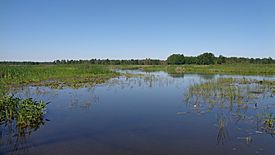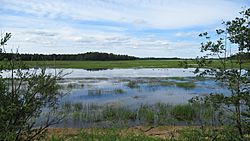Dead Stream Flooding State Wildlife Management Area facts for kids
Quick facts for kids Dead Stream Flooding State Wildlife Management Area |
|
|---|---|

View from N. Michelson Road (July 2019)
|
|
| Location | Muskegon River Enterprise Township and Lake Township, Michigan |
| Nearest city | Lake City, Michigan |
| Area | 1,024 acres (4.14 km2) |
| Elevation | 1,142 feet (348 m) |
| Governing body | Michigan Department of Natural Resources |
The Dead Stream Flooding State Wildlife Management Area is a special protected area in Michigan. It's a great place for nature and wildlife. This area is found along the Muskegon River. It's about 2 miles (3.2 km) from where the river starts at Houghton Lake.
The area covers about 1,024 acres (4.14 sq km). It includes parts of Enterprise Township and Lake Township. The Michigan Department of Natural Resources takes care of this important wildlife spot.
This wildlife area exists because of the Reedsburg Dam. The dam was built in 1940 on the Muskegon River. Its main job was to help stop flooding from Houghton Lake. The water held back by the dam created a large reservoir. This reservoir became known as the Dead Stream Flooding or Dead Stream Swamp. Its size changes, but it's usually around 540 acres (2.2 sq km).
Contents
Where is the Dead Stream Flooding Area?
The main office for this area is in Roscommon. You can find it at the Houghton Lake DNR Wildlife Office. The wildlife area itself is easy to reach. You can get there from U.S. Route 127 (exit 194) and County Road 300. This part of Michigan is not very crowded.
Other towns nearby include Houghton Lake to the southeast. Lake City is about 20 miles (32 km) to the west.
There are many other protected areas close by. These include North Higgins Lake State Park and South Higgins Lake State Park. Also, Hartwick Pines State Park is not far away. The forests around the Dead Stream Flooding area are also protected. They are part of the Au Sable State Forest and Pere Marquette State Forest. These forests are also managed by the Michigan Department of Natural Resources.
Fun Things to Do Here
This area is a popular spot for many outdoor activities. People enjoy camping, fishing, and hunting here.
Fishing and Boating
The waters are home to many types of fish. You might catch pumpkinseed or bluegill. There are also smallmouth and largemouth bass. Other fish include northern pike, yellow perch, and bowfin. You can also find native crayfish.
There are good spots for fishing from the shore. There are also two places where you can launch a boat. The Dead Stream Flooding is mostly shallow. It has many things underwater that can be tricky for big boats. So, smaller boats like canoes or kayaks are often better.
Hunting and Other Activities
The forests around the water are open for hunting during certain seasons. You can hunt for waterfowl (like ducks), turkey, and deer.
Besides hunting and fishing, many people come for other activities. These include bird watching, geocaching, and photography. Canoeing and kayaking are also very popular.
If you like camping, there's a rustic campground. It's called the Reedsburg Dam State Forest Campground. It's on the northeast side of the dam. The nearby North Higgins Lake State Park helps run this campground.
What's Happening Now?
Starting in August 2018, the Reedsburg Dam began a big repair project. This project meant the Dead Stream Flooding area was completely drained. This allowed the Muskegon River to flow naturally again. The dam needed repairs because it was almost 80 years old. Its earthen dike and concrete parts needed to be rebuilt.
During the construction, parts of the wetlands in the Dead Stream Flooding area dried up. This mainly happened around the Reedsburg Dam reservoir. The areas further upstream along the Muskegon River were not as affected.
The project was expected to finish, and the water levels were supposed to return to normal by summer 2020. However, the COVID-19 pandemic in Michigan caused delays. Even with the delays, over 90% of the dam project was finished. The construction was fully completed by September 2020. Now, the water levels are slowly being raised back to their original levels.





